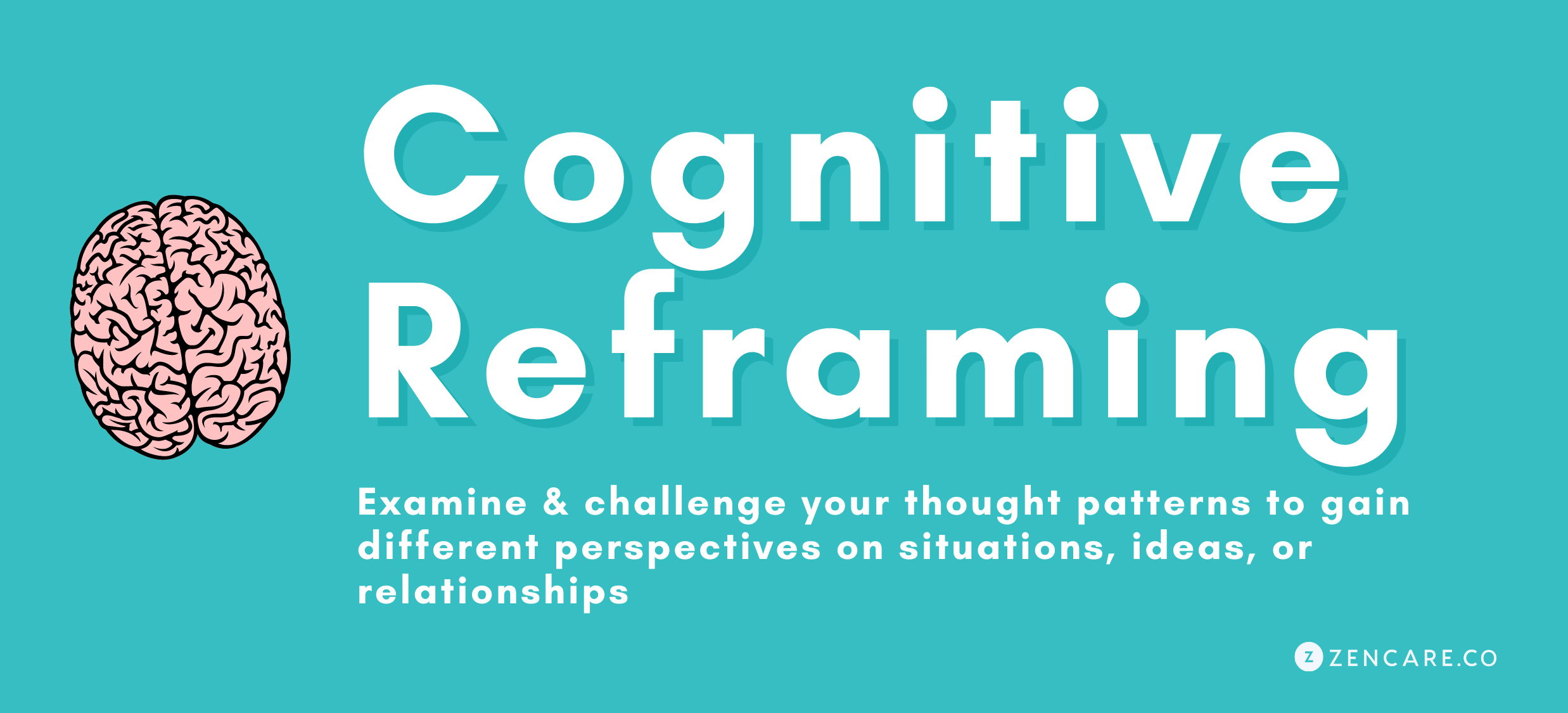“It is in the darkness of their own eyes that men get lost”– Black Elk
You know what’s funny about our mind? It lies to us all the time. Our mind loves to convince us that circumstances are the cause of our emotions.
For example, you might think “I’m sad because I didn’t get the job.” But here’s the thing: it’s not the outside circumstances that make us sad or anxious, it’s how we interpret them, how we think about them.
If I don’t get the job, I might actually be feeling sad because I’m thinking “I’m such a failure” instead of “I didn’t have all the qualifications.” Or I might be thinking “This career will never work out” instead of “I need to change my approach in the next interview.” Maybe I’m thinking “‘Nothing good ever happens to me” instead of “I’ll try again soon.”
When we get stuck in thought patterns that are distorted, untrue, or unhelpful, this can contribute to depression, anxiety, or other mental illness. And distorted thinking makes us less successful in both our professional and personal lives.
In this two-part skill, first you’re going to learn about 10 common cognitive distortions — ways that you think that make you feel anxious or depressed. Then in part two you’re going to learn what you can do about these cognitive distortions by changing how you think so you can change how you feel.
Negative thinking is comfortable. Have you ever heard someone say “I’d rather expect to fail and be pleasantly surprised than expect to succeed and be disappointed”? Negative thinking is just another subtle way to attempt to avoid pain. We seek to protect ourselves from disappointment by expecting the worst or labeling ourselves as broken.
Let me give you an example. Let’s start with the first cognitive distortion, all-or-nothing thinking.
James really wants to get a better job. He knows that to do this he needs to write a good resume. He works the evening shift so he has a lot of time in the day to do it, but each day he starts off by watching a lot of gaming videos on YouTube.
When his morning is over, he thinks “I should work on my resume.” But now he only has two hours before work, and he still has to shower and get ready.
He thinks “I’ve completely wasted my morning. My whole day is ruined. Why try? It’s not worth the effort.”
Now that he’s convinced himself that it’s pointless to put in effort, he’s also excused himself from doing the hard work of figuring out his resume. His all-or-nothing thinking protects him from feeling like he needs to work, but it also leaves him feeling depressed.
If you look carefully at each type of cognitive distortion, you’ll see that it does something for you. Distorted thinking helps us avoid responsibility, prevent risk, or try not to feel so vulnerable. This is called a secondary gain. We don’t notice that we’re doing it, but it does something for us.
Cognitive distortions may make you feel vindicated, but in the long run, thinking this way leaves you miserable.
Filtering
We take the negative details and magnify them while filtering out all positive aspects of a situation.
Polarized Thinking
In polarized thinking, things are either “black-or-white.” We have to be perfect or we’re a failure — there is no middle ground. You place people or situations in “either/or” categories, with no shades of gray or allowing for the complexity of most people and situations. If your performance falls short of perfect, you see yourself as a total failure.
Over-generalization
A general conclusion based on a single incident or a single piece of evidence is assumed. If something bad happens only once, we expect it to happen over and over again. A person may see a single, unpleasant event as part of a never-ending pattern of defeat.
Jump to Conclusions
Without individuals saying so, we know what they are feeling and why they act the way they do. In particular, we are able to determine how people are feeling toward us.
Catastrophizing
We expect disaster to strike, no matter what. This is also referred to as “magnifying or minimizing.” We hear about a problem and use what if questions (e.g., “What if tragedy strikes?” “What if it happens to me?”).
Personalization
Personalization is a distortion where a person believes that everything others do or say is some kind of direct, personal reaction to the person. We also compare ourselves to others trying to determine who is smarter, better looking, etc.
Control Fallacies
If we feel externally controlled, we see ourselves as helpless a victim of fate. For example, “I can’t help it if the quality of the work is poor, my boss demanded I work overtime on it.” The fallacy of internal control has us assuming responsibility for the pain and happiness of everyone around us. For example, “Why aren’t you happy? Is it because of something I did?”
Have you ever found yourself getting overly worked up or anxious about something… before it even happened? Built up a scenario in your mind of what an event will entail – without any real proof of how it will turn out? This is known as a cognitive distortion.
By identifying these distortions – essentially, tricks that our minds are playing on us – we can learn to isolate and overcome cognitive distortions using a tactic known as reframing.

What are cognitive distortions?
Before we dive straight into reframing, let’s determine what, exactly, a cognitive distortion looks like. In simplest terms, cognitive distortions are irrational thought patterns.
Dr. Taylor Chesney, a psychologist in New York City who specializes in Cognitive Behavioral Therapy (CBT) and is the director of the Feeling Good Institute, does a lot of work helping her clients identify and overcome their own personal cognitive distortions.
Dr. Chesney highlights a landmark description of cognitive distortions broken down by Dr. David Burns, in his book Feeling Good. These include:
- All or Nothing thinking: Seeing everything in a strict success/failure binary. For example, declaring that you will never overcome anxiety after one coping technique didn’t work, rather than deciding to try a different one.
- Overgeneralization: Taking one or two coincidences to mean that something is always or never true.
- Mental filter: Fixating exclusively on one incident and ignoring other situations that might contradict it.
- Discounting the positive: Disregarding positive experiences in order to justify harmful patterns.
- Jumping to conclusions: Making assumptions about what will happen or what others will think based on minimal or no evidence.
- Magnification: Inappropriate or inaccurate emphasis on negative and positive behaviors or attributes. Could be overemphasizing your struggles while minimizing your progress, or minimizing the harm of a behavior while overemphasizing the reasons for engaging in the behavior.
- Emotional reasoning: Coming to untrue or far-fetched conclusions based purely on emotion.
- Should statements: Setting yourself up to fail by idealizing unrealistic standards. For example, “I should always be able to control my anxiety.”
- Labeling: Conflating what someone did with what type of person they are. For example, labelling yourself as a failure because you didn’t meet a goal.
- Personalization/blame: Blaming yourself (or someone else) for an outcome that was not actually your fault or within your control.
“Most people think an upsetting event is what causes your stress or anxiety. Preparing for a talk? Stressful work meeting? Seems pretty straightforward that these anxiety-provoking situations cause your stress, right? Well, it’s really not true. What we know is, that it’s how you think about it that impacts how you feel!” says Dr. Chesney.
In other words, it’s not the presumably stressful event itself; it’s how we perceive and react to it. And if our automatic reaction is irrational, negative, and ultimately detrimental to our mental health? That, in a nutshell, is a cognitive distortion.
Wondering how to stop cognitive distortions? Enter reframing.

What is reframing?
“Reframing” is the CBT technique for stopping cognitive distortions. It is the developed habit of consciously changing how you feel during detrimental moments of cognitive distortions.
“When we have intense, negative emotions – such as depression and anxiety – our thoughts are often overly negative. These negative thoughts can intensify and prolong feelings of depression and anxiety,” says Dr. Bradley Miller, an adult psychiatrist and neuroscientist in New York City who specializes in psychotherapy and medications for individuals with depression and anxiety. Like a self-fulfilling prophecy of a downwards spiral, negativity can beget further negativity.
When you reframe the situation to cope and deal with it better, you’re allowing yourself to grow and expand your mindset.
Through cognitive reframing, we can learn to recognize our negative thought spirals and cultivate more realistic and positive thoughts.

How does cognitive reframing work?
The first step in cognitive reframing is identifying your own unique cognitive distortions. You then evaluate the evidence of said distortions, and – rather than embracing the negative thoughts – practice compassion towards yourself. Let’s break it down:
Practice noticing your cognitive distortions
Every time you’re experiencing a distortion, point it out to yourself. Dr. Chesney gives a common example: Feeling anxious before an exam.
Perhaps you predict you’re going to do poorly on the exam, so you focus on what materials you don’t know. You think everyone else will do better than you. And you start to fill your head with negative self-talk, like “I’m so stupid.”
When you notice yourself thinking something bleakly negative like that, stop the thought mid-flow by verbally saying “Stop!” out loud. Reassess your assumptions, and see if you can come up with a positive or neutral replacement.
Evaluate the evidence
Making a pros and cons list is a great exercise for all things in life, but try taking it a step further.
When a negative thought enters your mind, make a column of all the evidence that proves that notion, and a column of evidence that doesn’t.
You don’t have to believe the new positive thoughts right away, but seeing them written before you is a great first step.
Back to the example of the test: Have you studied hard? Reviewed the material in question? Be objective about your own dedication and hard work, rather than comparing yourself to others and assuming you’re the least prepared.
Practice compassion
Speaking kindly to yourself seems simple, but making a genuine effort each day to build yourself up and provide your heart and mind with internal love and support is a wonderful habit to make.
When getting ready for that test, tell yourself: “I’m smart, I’ve worked hard, I’ve studied the material I need to.” Your anxiety levels should start to go down.
“Over time, you develop more realistic and helpful thoughts, and these thoughts help to improve your mood,” says Dr. Miller.
What are the goals of cognitive reframing?
Cognitive reframing has short term and long term goals. In the short term, focusing on daily and balanced and positive thoughts is an incredible way to move your mindset from the negative and ultimately improve the way you think.
In the long term, Dr. Miller suggests repeated practice is the best way to shift your overall mood. “Cognitive reframing can lead to a long term shift in your thinking, and more balanced and positive thinking becomes automatic,” he said.
Regardless of where you are at in your cognitive reframing journey, be gentle with your thoughts. Be mindful that the negative ideas you are having can be reversed – and when possible, practice compassion with yourself.
Not sure how to implement reframing techniques into your everyday life? Working with a therapist who uses CBT in their approach can help you 1) identify negative thought patterns as they arise, 2) learn strategies and techniques to replace them, and 3) eventually empower yourself to overcome negative thinking.



